By Carolyn Purnell (Guest Contributor)

Diderot, Denis. Lettre sur les aveugles, à l’usage de ceux qui voyent. London, n.p., 1749.
In 1780, the philosopher Jean-Bernard Mérian made a daring proposal to the Prussian Academy of Sciences. He thought it prudent “to take [some] children from the cradle and raise them in profound darkness until the age of reason.”[1] To ensure that no light crept in, he added, the children should be required to wear blindfolds.
Sadistic as that may sound, Mérian had good intentions. The experiment was based on the common eighteenth-century idea that the impairment of one sense improves the action of others. Mérian argued that a constant stream of visual impressions distracts from other valuable sensations. Consequently, when “disencumbered of sight,” the children would develop “the most exquisite finesse” with their sense of touch.[2] “Their fingers would be like microscopes,” the delighted Mérian proclaimed.[3]
These tactilely gifted children would be well suited for training in the arts and manual crafts, and theoretically, it would be a win-win situation for everyone.[4] The students would have excellent job prospects, and France would have a talented workforce. Mérian billed this as an appealing option for poor families and argued that mothers should willingly sacrifice their children, with the hope that they could “one day become useful citizens.”[5]
An anonymous reviewer deemed the proposal “elegant, eloquent, and pompous,” but perhaps surprisingly, people did not seem to consider it entirely off-the-wall.[6] In many ways, Mérian’s thought was of a piece with that of other Enlightenment philosophers. In the latter half of the eighteenth century, sensation figured prominently in discussions about commerce, education, and human relationships. Blindness, in particular, was a hot topic.

“Aveugle des Quinze-vingt.” Études prises dans le bas peuple; ou, les Cris de Paris, seconde suite. Paris: n.p., 1737. ©Trustees of the British Museum
Prior to the eighteenth century, the blind had largely been relegated to a life of begging, but during the Enlightenment, many philosophers came to view blindness not as a disability but as an asset. For example, in his pedagogical treatise Émile, Jean-Jacques Rousseau recommended that students be educated in the dark. According to Rousseau, sight-reliant individuals are helpless half the time, whereas the blind are always self-possessed.[7] Jean Verdier, who founded a school for future bureaucrats, claimed that physical differences should be embraced, and he, too, lauded the blind: “In blindness, the art of supplanting sight with touch has even been seen to drive the mind to a point of perfection that the majority of men do not reach with all their senses.”[8] And Valentin Haüy, who founded the first school for the blind in 1783, sought to maximize his students’ manual talents by teaching them to work in a printing shop.

Guillié, Sébastien. Essai sur l’instruction des aveugles, ou exposé analytique des procédés employés pour les instruire. Paris: Imprimé par les aveugles, 1817.
Today, we balk at Mérian’s proposal to blindfold disadvantaged children, and the downsides of his theories are certainly evident. But as far as lessons go, they’re not all bad. For many eighteenth-century social reformers, disabilities were not “dis”-abilities at all. They were distinctive traits filled with social possibility. Philosophers did not aim simply to tolerate or accommodate the blind, instead stressing the unique social benefits offered by blindness. For all their misguided zeal, these reformers embraced difference and recognized its capacity to create a better, fuller, and richer world.
 C
C%20Mr.%20King_100dpi.jpg?1481906845) arolyn Purnell received her Ph.D. in European history from the University of Chicago. Her first book, The Sensational Past: How the Enlightenment Changed the Way We Use Our Senses (W.W. Norton & Co., 2017), uses ten episodes to explore the unexpected ways that people put their senses to use in the past.
arolyn Purnell received her Ph.D. in European history from the University of Chicago. Her first book, The Sensational Past: How the Enlightenment Changed the Way We Use Our Senses (W.W. Norton & Co., 2017), uses ten episodes to explore the unexpected ways that people put their senses to use in the past.
[1] Jean-Bernard Mérian, Mémoires sur le problème de Molyneux, ed. Francine Markovits (Paris: Flammarion, 1984), 180.
[2] Ibid., 185-6.
[3] Ibid., 186.
[4] Ibid.
[5] Ibid., 184.
[6] The Monthly Review; or, Literary Journal, London: n.p., 1782, 67: 551.
[7] Jean-Jacques Rousseau, Émile, trans. Barbara Foxley (London: Everyman, 1993), 116-122.
[8] Jean Verdier, Cours d’éducation à l’usage des elèves destinés aux premières professions et aux grandes emplois de l’état (Paris: Verdier, Moutard, Colas, 1777), 6-7.
